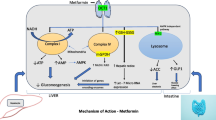Abstract
Purpose
The objective of the study was to determine the effect of a potent and selective CYP2C9 inhibitor, sulfinpyrazone (Anturane), on the pharmacokinetics of nateglinide (Starlix), a novel antidiabetic drug which is primarily (~70%) metabolized via CYP2C9.
Methods
This was a randomized, open-label, two-period, crossover study in 18 healthy volunteers. Nateglinide was administered as a single 120-mg oral dose alone (reference) on day 1 or in combination with sulfinpyrazone (test) on day 7, following twice-daily 200-mg oral doses (i.e., 400 mg/day) of sulfinpyrazone for 7 days. Pharmacokinetic parameters of nateglinide were determined following the administration of nateglinide alone, and when administered in combination with sulfinpyrazone. Plasma nateglinide concentrations were determined using a validated high-performance liquid chromatography method.
Results
The administration of nateglinide in combination with sulfinpyrazone resulted in ~28% higher mean AUC of nateglinide (90% CI for test-reference ratio: 1.20–1.39) with no differences in mean peak plasma concentration (Cmax; 90% CI test-reference ratio: 0.86–1.12) compared with nateglinide-alone treatment. The time to reach Cmax (tmax) and the elimination half-life of nateglinide were similar between the two treatments. Both treatments were safe and well tolerated.
Conclusions
Sulfinpyrazone increased the mean exposure of nateglinide by 28% when both drugs were administered in combination. Nateglinide, given as a single dose or co-administered with multiple doses of sulfinpyrazone, was safe and well tolerated in healthy subjects.


Similar content being viewed by others
References
Whitelaw DC, Clark PM, Smith JM, Nattrass M (2000) Effects of the new oral hypoglycemic agent nateglinide on insulin secretion in type 2 diabetes. Diabetes Med 17:225–229
Calles-Escandon J, Robbins DC (1987) Loss of early phase of insulin release in humans impairs glucose tolerance and blunts thermic effect of glucose. Diabetes 37:1167–1172
Keilson L, Mather S, Walter YH, Subramanian S, McLeod JF (2000) Synergistic effects of nateglinide and meal administration on insulin secretion in patients with type 2 diabetes. J Clin Endocrinol Metab 85:1081–1086
Weaver ML, Orwig BA, Rodriguez LC, Graham ED, Chin JA, Shapiro JM et al (2001) Pharmacokinetics and metabolism of nateglinide in humans. Drug Metab Dispos 29:415–421
McLeod JF (2004) Clinical pharmacokinetics of nateglinide. Clin Pharmacokinet 43:97–120
Novartis Pharmaceuticals (2002) Starlix (nateglinide tablets): prescribing information. Novartis Pharmaceuticals Corporation, East Hanover, NJ
Schlicht F, Staiger C, de Vries J, Gundert-Remy U, Hildebrandt R, Harenberg J et al (1985) Pharmacokinetics of sulfinpyrazone and its major metabolites after a single dose and during chronic treatment. Eur J Clin Pharmacol 28:97–103
He M, Kunze KL, Trager WF (1995) Inhibition of (S)-warfarin metabolism by sulfinpyrazone and its metabolites. Drug Metab Dispos 23:659–663
Miners JO, Birkett DJ (1998) Cytochrome P4502C9: an enzyme of major importance in human drug metabolism. Br J Clin Pharmacol 45:525–538
Rosenkranz B, Fischer C, Jakobsen P, Kirstein Pedersen A, Frolich JC (1983) Plasma levels of sulfinpyrazone and of two of its metabolites after a single dose and during the steady state. Eur J Clin Pharmacol 24:231–235
Mahoney C, Wolfram KM, Nash PV, Bjornsson TD (1983) Kinetics and metabolism of sulfinpyrazone. Clin Pharmacol Ther 33:491–497
Walter E, Staiger C, deVries J, Zimmermann R, Weber E (1981) Induction of drug-metabolizing enzymes by sulfinpyrazone. Eur J Clin Pharmacology 19:353–358
Lentjes EG, van Ginneken CA (1982) Determination of sulfinpyrazone and four metabolites and its application to pharmacokinetic studies in man. Pharm Weekbl 4:207
Note for Guidance on the Investigation of Drug Interactions (1997) Discussion in the efficacy working party (EWP), London, 17 Dec 1997, CPMP/EWP/560/95
Niemi M, Neuvonen M, Juntti-Patinen L, Backman JT, Neuvonen PF (2003) Effect of fluconazole on the pharmacokinetics and pharmacodynamics of nateglinide. Clin Pharmacol Ther 74:25–31
Sunkara G, Bigler H, Wang Y, Smith T, McLeod J, Prasad P, Ligueros-Sylvan M (2004) Nateglinide does not affect the pharmacokinetics or pharmacodynamics of acenocoumarol. Curr Med Res Opin 20:41–48
Kirchheiner J, Meineke I, Muller G, Bauer S, Rohde W, Meisel C, Roots I, Brockmoller J (2004) Influence of CYP2C9 and CYP2D6 polymorphisms on the pharmacokinetics of nateglinide in genotyped healthy volunteers. Clin Pharmacokinet 43:267–278
Author information
Authors and Affiliations
Corresponding author
Rights and permissions
About this article
Cite this article
Sabia, H., Sunkara, G., Ligueros-Saylan, M. et al. Effect of a selective CYP2C9 inhibitor on the pharmacokinetics of nateglinide in healthy subjects. Eur J Clin Pharmacol 60, 407–412 (2004). https://doi.org/10.1007/s00228-004-0778-4
Received:
Accepted:
Published:
Issue Date:
DOI: https://doi.org/10.1007/s00228-004-0778-4




